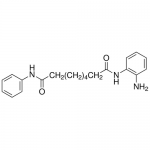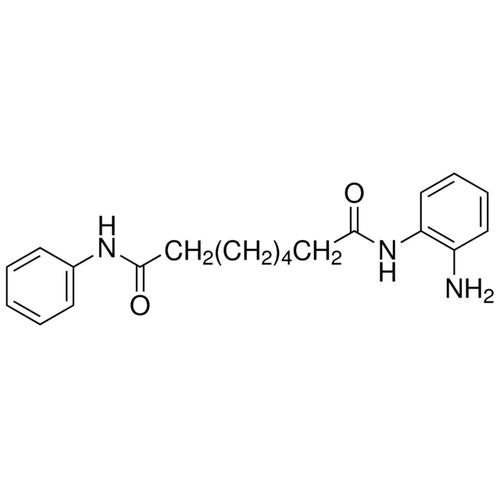| Product Name | Bml-210 |
| Description |
HDAC inhibitor |
| Purity | >98% (TLC); NMR (Conforms) |
| CAS No. | 537034-17-6 |
| Molecular Formula | C20H25N3O2 |
| Molecular Weight | 339.4 |
| Field of Use | Not for use in humans. Not for use in diagnostics or therapeutics. For in vitro research use only. |
Properties
| Storage Temperature | -20ºC |
| Shipping Temperature | Shipped Ambient |
| Product Type | Inhibitor |
| Solubility | Soluble in 25 mg/ml DMSO or 10 mg/ml Ethanol |
| Source | Synthetic |
| Appearance | Tan Solid |
| SMILES | C1=CC=C(C=C1)NC(=O)CCCCCCC(=O)NC2=CC=CC=C2N |
| InChI | InChI=1S/C20H25N3O2/c21-17-12-8-9-13-18(17)23-20(25)15-7-2-1-6-14-19(24)22-16-10-4-3-5-11-16/h3-5,8-13H,1-2,6-7,14-15,21H2,(H,22,24)(H,23,25) |
| InChIKey | RFLHBLWLFUFFDZ-UHFFFAOYSA-N |
| Safety Phrases |
Classification: Caution- Substance not yet fully tested. Safety Phrases: S22 - Do not breathe dust S36/37/39 - Wear suitable protective clothing, gloves and eye/face protection S24/25- Avoid contact with skin and eyes Hazard Statements: H413 – May cause long lasting harmful effects to aquatic life. |
| Cite This Product | Bml-210 (StressMarq Biosciences Inc., Victoria BC CANADA, Catalog # SIH-348) |
Biological Description
| Alternative Names | N1-(2-aminophenyl)-N8-phenyloctanediamide |
| Research Areas | Cancer, Cell Signaling |
| PubChem ID | 9543540 |
| Scientific Background | Bml-210 is a novel non-hydroxamic acid histone deacetylase (HDAC) inhibitor that has shown promising activity in epigenetic modulation. Although its primary research applications have been in oncology, particularly in inducing growth inhibition, apoptosis, and differentiation in leukemia cell lines, its mechanism of action is increasingly relevant to neuroscience. HDAC inhibitors are being explored for their neuroprotective effects, especially in the context of neurodegenerative diseases such as Alzheimer's and Huntington's disease. By modulating chromatin structure and gene expression, Bml-210 may influence neuronal plasticity, memory formation, and neuroinflammation. Its non-hydroxamic acid structure offers a unique pharmacological profile, potentially reducing off-target effects and improving therapeutic specificity. As interest in epigenetic therapies for neurological disorders grows, Bml-210 represents a valuable tool for probing the role of HDACs in the central nervous system. |
| References |
1. Savickiene J., et al. (2006) Eur. J. Pharmacol. 549: 9. 2. Herman D., et al. (2006) Nature Chem. Biol. 10: 551. |



Reviews
There are no reviews yet.